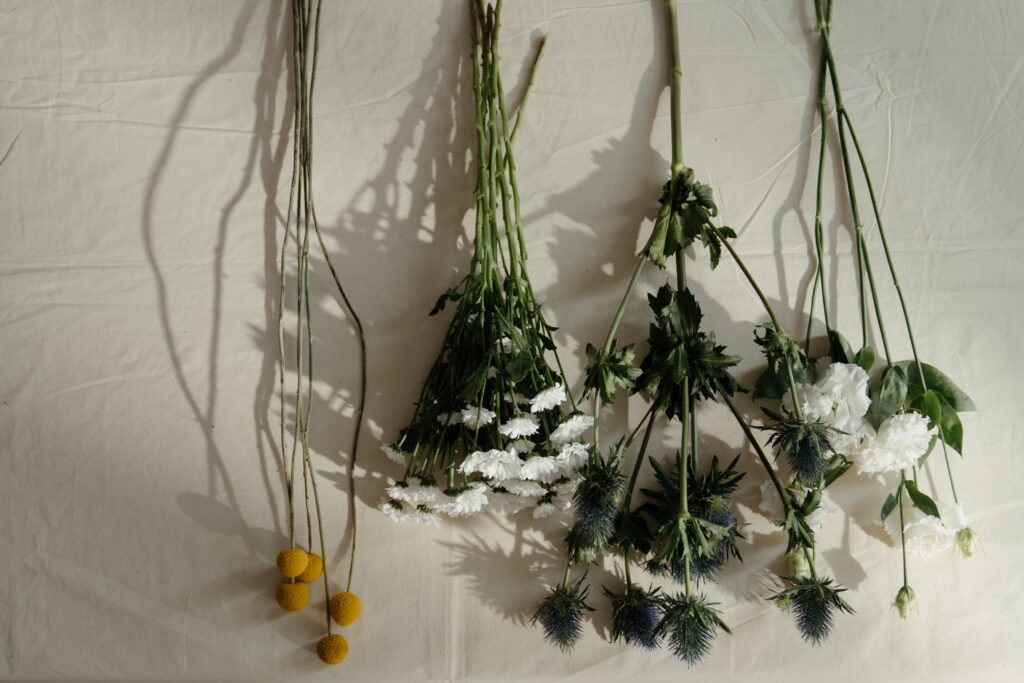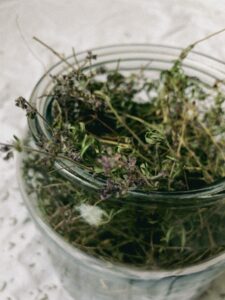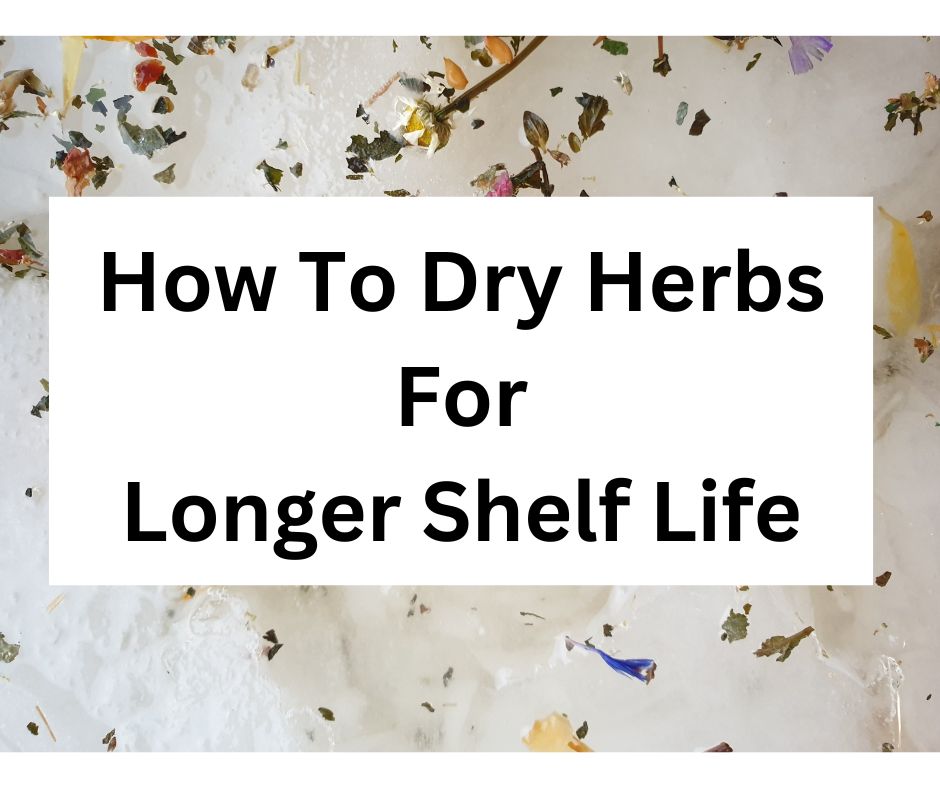You know this story all too well. You buy a fresh sprig of an herb called for in your recipe. What happens to the rest of the herbs. Most likely it will stay in your fridge until it goes bad. Why not try preserving the rest of your purchase it by drying it and increasing its shelf life.
Let’s face it, fresh herbs are best and work well in dishes like tossed salads or for garnishing your gourmet masterpieces. But dried herbs are the better option in soups and stews and other dishes that require slow cooking.
You can buy herbs fresh at the grocery store and dry them at home, but that can get expensive. Growing fresh herbs in your garden or on your kitchen windowsill would be ideal. Drying herbs is a great way to preserve them for future use. Home-dried herbs are a great way to save money, because drying your own garden grown herbs will cost a lot less than store bought.
You can also dry that bunch of fresh herbs you bought that you only needed a pinch from for your recipe instead of letting it spoil in the refrigerator.
This article will be your guide to drying herbs: everything you need to know from what’s the best way to dry them, and how long it takes for different methods of drying. Drying your herbs allows you to use them in many ways, including cooking, making herbal tea blends and including them in homemade beauty products.
Benefits of drying Herbs

Dried Herbs
Drying herbs help preserve the herbs for later use, by removing moisture from it, allowing you to store it for a longer period of time. The most common methods of drying are sun-drying, air-drying, freeze-drying, and oven drying. Many people also use microwave ovens to dry their herbs.
Dried herbs are often crushed, which concentrates their flavor, making them more potent than fresh herbs. Fresh herbs have a higher water content, so they’re not as strong. If you’re making a swap, use less dried herbs than you would fresh. To make a substitution that calls for fresh herbs, swapping dried for fresh herbs, use 1/3 of the amount of the dried herbs called for in the recipe.
Good Options To Dry
Good options to dry include oregano, marjoram, lemon balm, basil, thyme, rosemary, bay leaf, curry leaf, and fennel seed are all good dried. If you’re buying your herbs, be sure to begin with high quality herbs, preferably purchase organic herbs. If you’re selecting herbs from your own garden, harvest herbs in the early morning, right after the morning dew. Your herbs will have more flavor if you harvest them before the sun evaporates their essential oils. Your herbs will have the best flavor when picked early in the morning.
Overview of the Various Drying Methods
There are various drying methods you can use for your herbs. The most common methods of drying are sun-drying, air-drying, freeze-drying, and oven drying. Sun-drying is the oldest method of drying and it mainly occurs in countries that have a lot of sunshine year-round. However, sun drying can cause herbs to lose their color and flavor and is not a preferred method.
Air-drying and sun drying are very common methods because there are no requirements for heat or additional equipment. Freeze-drying is mainly used on foods that need to be preserved for long periods of time., such as berries.
Oven drying is usually done on foods that need to be dried very slowly in order to avoid some loss of flavor, such as vegetables. Drying methods will affect the physical and chemical properties, as well as change the food’s appearance and taste. It may also affect its nutritional content, but you have the benefit of increasing shelf life.
Most raw foodists agree that cooking any food over 120 degrees Fahrenheit destroys valuable life-giving enzymes. Enzymes help with the digestion process; they breakdown foods into smaller molecules that are more easily digested and absorbed. Low temperatures maintain the enzyme integrity of your food. Keeping this in mind, for all the methods listed below, please use the lowest temperature possible.
Let’s take a closer look at the various options you have for drying your herbs.
Air Drying

Air drying is also a very common method because there are no requirements for heat or additional equipment. Herbs retain their vibrant color when air-dried. Sturdy, hardy herbs like Rosemary, Sage, Thyme are the easiest to dry. Tie your herbs into small bunches and hang from racks in a warm, well-ventilated area.
Tie your tender herbs (such as basil, tarragon, and mint) in bunches and place them inside a paper bag. Punch vent holes in the bag and secure the top with a rubber band. Your herbs will be dry in about 5 – 10 days. They should crumble easily, and the stems are brittle and break easily. This method is often used to dry flowers or bouquets.
Freeze Drying

Commercial freeze dying is different than home freeze drying. When you freeze dry at home, you’re freezing the herbs in ice cubes. Freeze-drying is mainly used on foods that need to be preserved for long periods of time, such as berries and other fruit.
Clean your herbs, remove damaged leaves and stems and store in air-tight freezer bags. You can also chop your herbs and place in ice cube trays. Pour water in between spaces and freeze. When frozen, store in air-tight freezer bags, ready to pop in your soups or stews as needed. Freeze drying can last years.
Microwave Drying
An easy way to dry your herbs is in the microwave if you have a small quantity (like a cup or two). This is the speediest method as it doesn’t take much time at all. Typically microwaves heat at about 212 degrees Fahrenheit, or boiling point. To dry your herbs in the microwave, spread your leaves and tender stalks (remove any woody stems) evenly on a paper towel. Cook for 30 seconds, toss them, and continue to cook in 15 to 30 seconds increments, until your herbs are dry. Herbs will retain their bright color when dried in the microwave.
Drying Your Herbs with an Air Fryer
The Air Fryer is another option if you have a small quantity of herbs to dry. Lay your herbs in a single layer on a vented rack. Place a metal sheet on top to keep them from flying in the air while drying. Dry at 120 degrees for 1 to 2 hours. Should be crispy to touch and ready to store. If 120 degrees is not possible, dry at the lowest possible setting. Monitor often to make sure you’re not over drying. When crispy to touch, they’re ready to store.

Oven Drying your herbs
To dry your herbs in the oven, follow the steps below.
1. Preheat the oven toto the lowest temperature possible on your oven. My oven can cook at 170 degrees Fahrenheit. Most ovens have a low temperature of 200 degrees Fahrenheit. This temperature may destroy some of the natural enzymes in your herbs.
Rinse your herbs thoroughly using cool water. Remove any damaged or dark areas from your leaves. Let them dry completely before placing them on your cookie sheet (or baking sheet).
2. Place the herbs on a baking sheet lined with parchment paper and bake for 1-2 hours at the lowest setting, checking periodically to ensure that they don’t burn.
3. After an hour, turn off the oven and leave the herbs in there until they are fully dried out – usually 1-2 hours more depending on how moist they were when you put them in the oven.
Dehydrator Drying (using a food dehydrator)
If possible, buy a dehydrator that lets you control or select the temperature. Drying herbs is a simple process with drying time in as little as 2 hours. The most important thing to remember is that the temperature should not exceed 120 degrees Fahrenheit or 48 degrees Celsius. By using a lower temperature setting than the oven method, you preserve more of the enzymes of the herbs.
The duration of drying herbs will vary depending on the type of herb and the temperature. Some herbs, such as lavender, can take up to 24 hours to dry. Other herbs, such as rosemary, only need about 2 hours. Wash your herbs in cool water, toss damaged leaves and stems. Line your trays with parchment paper and spread the herbs in a single layer, evenly on the dehydrator trays. Make sure your dehydrator trays are spaced on the racks to allow good air circulation.
How long will your Dried Herbs last?
In order for your dried herbs to retain their flavor, you should store them in an airtight container in a cool, dry place. Make sure that you don’t store them near any heat sources as this will cause the flavors to fade quickly. Over time your dried herbs will begin to lose flavor intensity and color. But as a general rule, your dried herbs can last up to 3 years.

